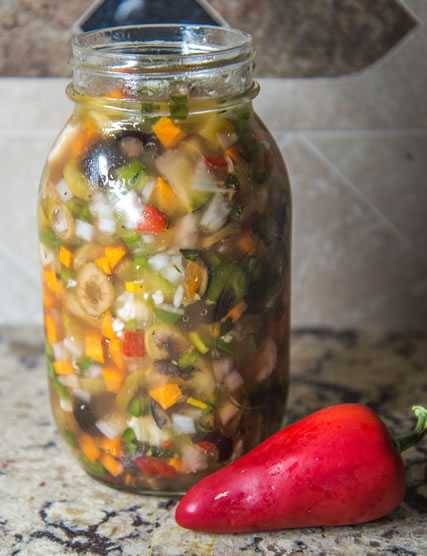Fresh vegetables are the star of the show in this delicious recipe for giardiniera.
Giardiniera (pronounced jar-DEE-nyair-a, but the Americanized pronunciation is something like jar-DIN–yair) is an Italian word that means roughly “a female gardener” or “from the garden.” It is a condiment made from fresh vegetables, chopped into small bits, and used to top sandwiches and other foods. Technically it is a relish, but it is not at all like an American sweet pickle relish. There are two basic versions: Sicilian style, probably from Sicily, packed in vinegar, and Chicago-style packed in oil.
In Chicago, giardiniera is extremely popular and can be found in the hundreds of restaurants that serve Italian Beef Sandwiches and Italian Sausage Sandwiches where it is practically a required topping. It is in every grocery, and a jar of giardiniera can be found in the door of every Italian American fridge in Chicago. And many others.
In New Orleans, it is used to top muffuletta sandwiches and on nachos at sports stadiums. It can also be used on meatball sandwiches, mortadella, bologna, and practically any other sandwich. Some folks serve it straight with antipasto, straight as a salad, on a salad, in soups, or sauces. Rachael Ray puts it on pasta, and I know of people who use it on scrambled eggs. Think of giardiniera as more of a topping than a relish. Relish is too confining a term for this adaptable condiment.
The Chicago style should not be made at home because it is packed in oil and must be specially processed at a specific level of acidity and cooked at a minimal heat to ensure no botulism spores can survive at room temp. Typically, it is made by salting the veggies aggressively overnight, rinsing, soaking in vinegar, rinsing, packing in oil with oregano, and sterile bottling with high heat. There is no single recipe for giardiniera in Chicago. There are at least a dozen on the store shelves. The exact ingredients and method vary from house to house and bottler to bottler, and it can be made from mild to hot with infinite grades in between.
This recipe is closer to the Sicilian style which is simply chopped fresh veggies with vinegar, and salt. Pickled veggies.
A classic simple recipe is just celery, carrots, cauliflower, and hot peppers sterile packed in oil. A popular commercial Chicago brand, Dell’Alpe, is serrano peppers, celery, green olives, and spices. First, they pickle everything in salt and vinegar, drain, submerge the pickled veggies in oil, and heat pasteurize to prevent botulism. The people who make the Marconi brand and the giardiniera for the Portillos restaurants, famous for Chicago Hot Dogs and Italian Beef Sandwiches, use the same ingredients but they add cauliflower and carrots. Pagliaci adds capers. Some kick it up with hot peppers.
Below is my homemade recipe, heavily influenced by a recipe taught to me by my sister-in-law Theresa Tortorello. She is an accomplished Italian American home cook who learned her recipes at the aprons of her immigrant family’s women. She makes a large quantity of her Italian-style giardiniera in August using the bounty of her garden.
Theresa and I like lots of stuff in it. I add onions, garlic, sweet bell peppers, zucchini, and fennel bulbs. You can increase or decrease ingredients to your taste. If you can’t find fennel bulbs, skip them. Want more garlic, go for it. Love pain, add Scotch bonnets. I recommend you start with my recipe and then, after aging it for a few days, you can add more ingredients if you wish. But Chicagoans: Remember, my recipe is more Italian-style. It uses vinegar to make sure it is low enough in pH (acidic) to discourage microbial growth. It can be stored in the fridge for several weeks. Packing in oil is too risky because botulism loves this environment, and scrubbing the veggies is just not good enough to pasteurize them.
Giardiniera can also be canned if you know how. For more info on canning go to the Ball Mason Jar company website FreshPreserving.com.
Makes:
Takes:
Ingredients
- 1 cup canola oil
- 1/2 cup red wine vinegar
- 3/4 cup hot peppers
- 1/4 cup sweet peppers
- 1/4 cup green or yellow zucchini, or both
- 1/4 cup celery stalks
- 1/4 cup carrots
- 1/4 cup cauliflower
- 1/4 cup onion
- 1/4 cup fennel bulb
- 6 ounces pitted green olives (or black)
- 3 garlic cloves
- 1/4 cup fresh basil
- 1/4 Cup fresh oregano
- 1/2 teaspoon finely ground black pepper
- 1 teaspoon Morton Coarse Kosher Salt
These recipes were created in US Customary measurements and the conversion to metric is being done by calculations. They should be accurate, but it is possible there could be an error. If you find one, please let us know in the comments at the bottom of the page
Method
- Prep. Whisk the dressing ingredients together in a bowl and set aside.
- Make sure all the vegetables are thoroughly washed. Remove the seeds and stem from the hot peppers and sweet peppers. Chop the peppers into 1/8-inch (3.2 mm) chunks. Chop the zucchini, celery, carrots, cauliflower, onion, and fennel bulb into 1/8-inch (3.2 mm) chunks. Slice the olives into rings and finely mince the garlic. Chop the basil and oregano.
- In a bowl, mix the vegetables, olives, garlic, herbs, and pepper together.
- Spoon the veggies into a very clean jar and top them off with the liquid. Make sure the solids are covered in liquid and use a kitchen knife to dislodge large bubbles. If you need it, pour in more oil and vinegar, about 2 parts oil to 1 part vinegar. Screw on a tight fitting very clean lid and refrigerate.
- Serve. You can use it immediately, but you should give it at least three days to allow the juices from the veggies to come out and the flavors to marry. Then shake and taste and make additions as you see fit. It will keep for weeks in the fridge. If you know how to sterile can, you can put a batch up for use all winter.




High quality websites are expensive to run. If you help us, we’ll pay you back bigtime with an ad-free experience and a lot of freebies!
Millions come to AmazingRibs.com every month for high quality tested recipes, tips on technique, science, mythbusting, product reviews, and inspiration. But it is expensive to run a website with more than 2,000 pages and we don’t have a big corporate partner to subsidize us.
Our most important source of sustenance is people who join our Pitmaster Club. But please don’t think of it as a donation. Members get MANY great benefits. We block all third-party ads, we give members free ebooks, magazines, interviews, webinars, more recipes, a monthly sweepstakes with prizes worth up to $2,000, discounts on products, and best of all a community of like-minded cooks free of flame wars. Click below to see all the benefits, take a free 30 day trial, and help keep this site alive.
Post comments and questions below
1) Please try the search box at the top of every page before you ask for help.
2) Try to post your question to the appropriate page.
3) Tell us everything we need to know to help such as the type of cooker and thermometer. Dial thermometers are often off by as much as 50°F so if you are not using a good digital thermometer we probably can’t help you with time and temp questions. Please read this article about thermometers.
4) If you are a member of the Pitmaster Club, your comments login is probably different.
5) Posts with links in them may not appear immediately.
Moderators